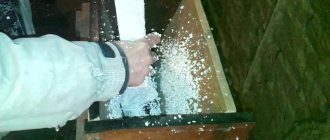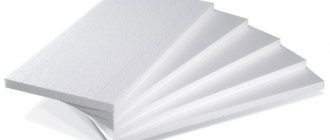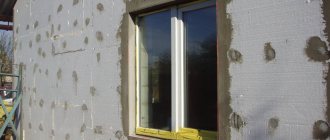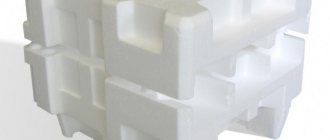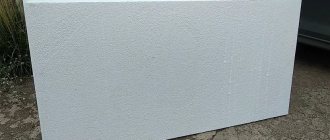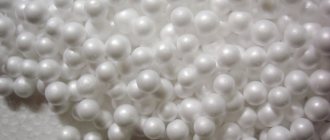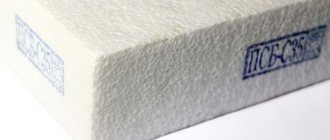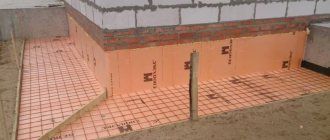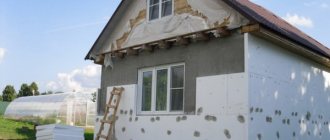The Internet has made it easier to access any information. People can not only learn and read almost anything, but they can also create news themselves. Often the professional and amateur opinions of the authors of different articles on the same topic are diametrically opposed.
The debate is especially intense when it comes to safety and health. The question of whether polystyrene foam is harmful or safe is one of these. Let's figure it out: expanded polystyrene - what is it?
What is polystyrene foam or expanded polystyrene?
First you need to understand what polystyrene foam is and how it behaves under various influences. And understand whether polystyrene foam is harmful to health?
Expanded polystyrene is a gas-filled material. They are made by steam heating polystyrene granules. These granules are first filled with gas. The gas used is different: in ordinary polystyrene foam, natural gas is used, in fire-resistant foam, carbon dioxide is used. When heated, the gas expands, and the granules increase many times in size (15 - 30 times the original).
If nothing restrains the expansion of granules, then the result is a crumbly material that is used in filling frameless furniture, packaging, and construction. To obtain solid forms of polystyrene foam, foaming is carried out in a closed form of the desired configuration. This is how flat sheets of insulation, embossed decorative products, boxes for packaging household appliances and much more are obtained.
The resulting material has a number of very advantageous qualities:
- high thermal insulation;
- high durability;
- low water absorption;
- low vapor absorption;
- biological stability;
- unattractive to rodents and parasites.
Polyfoam is an inexpensive, very light, practically non-moisture-absorbing material with low thermal conductivity. It is resistant to rot and biocontamination, durable, can take any shape and be elastic, but hard enough to hold its shape.
Thanks to this, expanded polystyrene has become widely used in many areas:
- In ammunition for safety (both military and civilian). In helmets, knee pads, and elbow pads, polystyrene foam is used as a shock-absorbing material and insulation.
- For the production of disposable tableware. Containers for hot food and cups for drinks are widely used.
- As packaging material. Expanded polystyrene protects fragile items well during transportation. It can be used both in bulk and in the form of pressed forms of the desired profile.
- For the manufacture of children's toys and child safety products.
- For frameless furniture (poufs, bean bag chairs).
- When making blanks for handicrafts and creativity.
- For the manufacture of decorative elements of the interior and garden decoration (fake stones, garden figures)
- In some countries (Japan, Finland, Norway, Canada, USA), polystyrene foam is used in road work to protect soil from freezing, reduce the vertical load on soils prone to subsidence, create artificial unevenness, etc. In Russia, polystyrene foam is not used for this purpose .
- For interior and exterior finishing. Various decorative elements of facades, ceiling tiles, imitation stucco molding and much more are made from expanded polystyrene.
- In the production of polystyrene foam, concrete and polystyrene foam blocks for the construction of walls in low-rise construction.
- For the manufacture of various heat-insulating and sound-insulating materials.
Polystyrene foam packaging
Myth one: good insulation
The thermal insulation properties of this material depend on the manufacturing method and operating conditions:
- In normal condition, at a temperature of +25°C, the thermal conductivity coefficient of polystyrene foam and other similar insulation materials is 0.034-0.045 W/mK. Some manufacturers even bring this figure to 0.019 W/mK.
- The structure of polystyrene foam with a low density (about 17 kg/m³) leads to an increase in water absorption - the figure can reach 350-900% by weight. This is possible, for example, if there are defects in the waterproofing carpet. With such indicators, the thermal conductivity coefficient will be much higher than those given in the first paragraph.
- In residential areas, humidity increases even more. Firstly, each living person releases approximately 100 grams of moisture every hour. Secondly, during operation, humidity increases after washing, cooking, etc. In such conditions, standard indicators are possible only with high vapor permeability of the insulation.
Vapor permeability of expanded polystyrene
Compared to fiberglass and mineral insulation, expanded polystyrene has low vapor permeability (approximately 0.06 mg/mhPa), which helps reduce the diffusion of water molecules through walls by about 50-55%.
In houses insulated with polystyrene foam, even with high-quality ventilation, the humidity will be increased (more than 70% at a temperature of +19 °C). Such indicators contribute to the formation of fungi.
How do foam products affect the environment?
Of course, such a proliferation of material and its daily participation in human life makes one wonder: is polystyrene foam harmful or safe?
Manufacturers declare that one of the most important performance qualities that polystyrene foam possesses is environmental friendliness. But their interest is quite understandable. That is why, when determining whether polystyrene foam actually harms the environment, it is better to turn to scientific research.
Expanded polystyrene under a microscope
The environmental friendliness of any material is determined by its own impact on the environment, the impact under certain conditions and when interacting with other substances.
Moreover, it is necessary to consider both the immediate impact and the long-term one. Here are the main influencing factors:
- Expanded polystyrene practically does not absorb water and does not interact with it at all. Therefore, its use, for example, in finishing and insulating facades, is not only effective, but also safe. It follows from this that ceiling tiles made of foam plastic, if not heated, pose no harm.
- Expanded polystyrene does not oxidize when exposed to air and does not decompose when exposed to ultraviolet radiation. These qualities allow polystyrene foam to be disposed of in a household waste dump, rather than at a specialized chemical site.
- Expanded polystyrene is not dissolved by any substances that it might come into contact with in a household waste dump. Solvents for it are acetone, original styrene, aromatic and chlorinated hydrocarbons. These substances are not (or at least should not be) found in household waste dumps.
- Expanded polystyrene is a very durable material. Cyclic stability tests with annual temperature changes in the range from -40 ° C to +40 ° C with exposure of the material to ultraviolet radiation and water showed that even after 80 cycles (which corresponds to 80 years), the structure of polystyrene foam remained unchanged.
- Temperature extremes are not typical for polystyrene foam use conditions, but have also been studied. When heated without an open flame source, even polystyrene foam not treated with fire-fighting substances begins to collapse only at 300 °C, and with an open flame - at 210 °C. The impact of low temperatures can not be taken into account at all, since destruction occurs only superficially, and even then at -310 °C.
Unfortunately, the bulk of used polystyrene foam is disposed of in household waste landfills. When buried, polystyrene foam is practically harmless to the environment, since it does not interact with water and air, but it does not decompose.
The situation is complicated by the fact that the collection and processing of polystyrene foam is not economically profitable today. During processing, expanded polystyrene can be used to produce polystyrene, however, the cost of this process is comparable to the production of polystyrene from primary raw materials, but requires a more complex organization of the process.
Another way to process expanded polystyrene is to grind it for use in the production of concrete - expanded polystyrene blocks, filler for heat-insulating mixtures and similar materials. This is a promising area of recycling that offers hope for reducing landfills.
Pile of old foam plastic
It is too early to say what harm polystyrene actually causes or will cause to the environment. The material is very durable. Even the first mass-produced foam plastics, buried in landfills long ago, have not yet approached the threshold of decomposition.
Main Application
The process of insulating a roof from the inside with polyurethane foam. This common polymer has found wide application in various spheres of human activity. It is most widely used in construction: insulation with this material is very effective.
It is also used as a cold insulator and arch support. Many manufacturers often use polyurethane foam as a filler for upholstered furniture, mattresses and pillows, since it is quite soft in foam blocks.
Attention: a mattress or pillow made of such material can actually harm human health, although suppliers claim otherwise.
The influence of polystyrene foam on human health
Questions about whether polystyrene foam is harmful to health or not have worried consumers almost from the very beginning of its use. Each new finishing and building material based on foam plastic caused a renewal of these disputes.
Proponents of the use of expanded polystyrene cite the research of scientists - chemists, physicists and materials scientists - as a safety argument. Expanded polystyrene, without external influences on it, practically does not interact with the environment.
Its molecular structure is very stable. The experiments described above show that under normal human conditions, polystyrene foam does not emit any harmful substances. Actually, it does not release any substances.
If you use polystyrene foam at temperatures from -40°C to +40°C, then you don’t have to worry about the harmful effects of polystyrene foam on health.
Might be interesting
Thermal insulation
Insulating the ceiling in a bathhouse - methods, materials, useful...
Thermal insulation
Tables of comparative characteristics of thermal insulation…
Thermal insulation
Why polyurethane foam insulation is the best...
Thermal insulation
Self-adhesive thermal insulation: how to choose and apply?
Opponents of the use of expanded polystyrene claim the possibility of styrene release. Even if not under ordinary, but under extreme conditions. Extreme conditions refer to exposure to high temperatures. Indeed, when burned, polystyrene foam, like many other substances, releases a large amount of toxic substances, among which styrene is considered especially toxic.
Effect of styrene on humans:
- dizziness;
- irritation of the mucous membranes of the eyes;
- high concentrations lead to lung damage and even fatal poisoning;
- the functioning of the kidneys, liver, and hematopoietic system is disrupted;
- oncology.
It is worth recalling that the separation of styrene from polystyrene foam under normal human operating conditions is impossible. Styrene is released only when polystyrene foam burns.
The flammability of the initially created polystyrene foam was quite high. At temperatures above 210 °C, the foam was able to independently support surface combustion and spread fire. That is why fire retardants (substances that inhibit ignition and flame spread) are now used for the production of construction and finishing polystyrene foam.
Thanks to this, it was possible to reduce flammability and increase the ignition temperature to 440 °C. In addition, most modern polystyrene foam products do not allow flames to spread and do not support spontaneous combustion.
The harmfulness of highly concentrated styrene to human health is great: it should be remembered that the release of styrene from polystyrene foam is unlikely from a chemical and physical point of view, especially if operating rules are followed and measures are taken to prevent fire.
It must be said that, like many other substances that are dangerous in large doses, but harmless in small doses, styrene is naturally found in many products that we use every day - coffee, tea, cinnamon, cheese, strawberries and so on.
Melting polystyrene foam
An exception to the permissible scope of use of expanded polystyrene is roof insulation. Yes, materials based on polystyrene foam are recommended by manufacturers as excellent roof insulation, but we must remember that a roof, especially a metal one, can get very hot under the sun. Despite the fact that the decomposition of polystyrene foam begins at a temperature significantly higher than that to which the roof can be heated naturally, the danger of styrene release will still exist. To insulate the roof, it is better to use mineral wool and similar materials.
The harm of expanded polystyrene to human health may also be associated not so much with the qualities of the material, but with its improper use in finishing. Expanded polystyrene is a very popular thermal insulator, but at the same time it does not allow steam and moisture to pass through. It happens that people, out of ignorance or out of economy, insulate the walls between the apartment and the street from the inside with sheets of expanded polystyrene.
This situation is serious because the moisture in the warm home air collides with the cold wall directly under the foam and condenses there. The wall on the concrete surface is constantly wet, which will inevitably lead to the development of fungus and black mold, the spores of which are a dangerous allergen. Black mold can trigger the development of asthma, chronic bronchitis and other diseases.
Walls can only be insulated with polystyrene foam outside the apartment to prevent condensation from forming.
Myth two: long service life
Expanded polystyrene, made by pressing or non-pressing methods, loses its ability to retain heat quite quickly - within 8-10 years. For a residential building this is a catastrophically short period of time!
Such indicators are caused not only by the process of natural destruction of the material, but also by careless operation of the house or major repairs using volatile hydrocarbon compounds. It turns out that the initial benefit from using polystyrene foam turns into multimillion-dollar heating costs in the future.
Let us give one sad example.
- Underground commercial pavilion (Moscow) . Always in just 2 years, huge cracks have formed on the insulation. The thickness of the material has decreased significantly, but the density, on the contrary, has increased almost 4 times! All this led to a decrease in the heat transfer resistance coefficient from 0.31 to 2.6 m² °C/W. Reason: temperature and humidity conditions were not taken into account.
The exception is extruded polystyrene foam , which is very popular in Europe. However, it is recommended to replace it only as insulation for artificial ponds or road surfaces, or to provide thermal insulation for basements. Under such conditions, extruded polystyrene foam retains its properties for up to 50 years of operation.
Rules for safe use
How to minimize harm from polystyrene foam, you need to take into account a number of rules:
- You cannot insulate rooms with high temperature changes;
- do not insulate the ceiling of a balcony or loggia, and those places where direct sunlight may fall;
- look at the certificate when purchasing, try to buy material in large retail chains;
- systematically ventilate the room;
- Humidifiers and ionizers cannot be used if there is foam insulation;
- The kitchen should have a good hood with air venting.
It must be remembered that styrene can be released when heated, so it is better to insulate areas that will not get very hot with foam boards.
Conclusion
We tried to dispel all the most common myths regarding the use of polystyrene foam as insulation. There can be only one conclusion - expanded polystyrene should be completely excluded from the construction process . Only in this case can such sad events as, for example, the fire in the Perm club “Lame Horse”, where 156 people died, be avoided.
Now there are many effective substitutes for polystyrene foam - which means there is no longer a single compelling reason to continue to use harmful materials in construction.
Tags: polystyrene foam
FAQ
Let's look at a number of questions about polystyrene foam and give answers to them.
Are foam ceiling tiles harmful?
To answer this question, you need to understand where the tiles will be installed. It cannot be installed in the kitchen, as sudden temperature changes are possible, and the surface is difficult to clean from a layer of dirt. You can install tiles in other rooms, but you just need to remember that the lighting should not heat up the foam tiles so that styrene does not release.
At what temperature do harmful substances release from polystyrene foam?
As already written above, the temperature should be above +40°C or below -40°C.
Why are polystyrene foam or polystyrene foam harmful?
The material itself is not harmful to human health, but if it is heated, styrene will be released, which is very dangerous.
What is polyurethane foam and what properties does it have?
When applied to the surface, polyurethane foam foams. First, you need to understand what polyurethane foam is. Polyurethane foam is a modern building material belonging to the group of plastics that are filled with gas. Polyurethane foam includes an inert gas.
Polyurethane foam, which is produced by Russian and foreign manufacturers, has low thermal conductivity, complete vapor permeability, and water resistance. However, in addition to positive qualities, this substance also has one negative one.
Thus, during combustion, polyurethane foam can release toxic substances into the atmosphere in the form of formaldehyde, which lead to various poisonings. Therefore, we can conclude that when burned, the toxicity of this substance is high.
Release of other toxins
But styrene isn't the only toxin released from foam. Scientists have proven the presence of phenol and formaldehyde in vapors.
The latter can cause very serious damage to a person:
- Inhalation causes bronchitis and asthma.
- Ingestion of the substance can lead to stomach bleeding and kidney and liver failure.
- When it comes into contact with the skin, the toxin provokes dermatitis, rashes and eczema.
Phenol is more dangerous because it is a strong poison. And poisoning can even lead to death if you do not seek medical help in time. And in order to save a person’s life, it is often necessary to administer an antidote.
Saving a person from poisoning Source toksikolog.com
Technological features of installing Penoplex on various surfaces
The maximum return from insulation can only be achieved if it is installed correctly on a particular surface. The technology for installing Penoplex in different places is somewhat different.
Insulation of facades
Many consumers prefer to save money and therefore violate the technology of installing Penoplex on the walls of the facade of the house. Usually they simply attach it to dowels with wide mushroom caps. This can cause mold and mildew to appear. Wall insulation must be done according to all the rules:
- The wall is cleaned of dust and dirt, and then primed.
- Irregularities on the walls should be plastered and primed again.
- At the bottom of the wall, an L-shaped profile is attached, which is called the starting profile. The laying of slabs begins with it. The first row of slabs is simply installed on this guide profile.
- The slabs are glued to the wall surface using special glue. It is applied to the slab, which is then pressed forcefully against the wall. The slabs are glued according to the brickwork pattern. This minimizes the risk of cold bridges forming.
- Only after the slabs are glued are they fixed with dowels - “fungi”. You need 5 - 6 pieces per 1 m2. The caps of fungi should be pressed into the insulation to their thickness in order to be flush with the surface of the slab. To install the dowel, holes of the required diameter and depth are drilled directly through the insulation. A “fungus” is inserted into them, into which a special plastic nail is driven. In the process of entering inside, it expands the leg of the “fungus”, holding the dowel tightly inside the wall.
- The corners of the house are reinforced with special perforated corners, and the entire surface of the insulation is reinforced with a special fiberglass mesh glued to the plaster mortar.
- Next, the surface of the slabs can be plastered with any composition.
Due to their increased density, Penoplex slabs can be plastered with any plaster. Relief and textured compositions are often used. Facades finished in this way not only perfectly retain heat in the house, but also look very presentable.
Insulation of balconies and loggias
When insulating walls on a balcony and loggia, it is worth knowing about some features. Firstly, all joints between Penoplex boards must be glued with foil tape and filled with polyurethane foam. When cold bridges are completely eliminated, another foil insulation is glued over the resulting surface. The entire structure can be covered with clapboard or plaster.
Roof thermal insulation work
The roof is usually insulated at the construction stage or during reconstruction. To do this, plank sheathing is installed from the attic side to the lower surface of the rafter legs. A vapor barrier membrane is placed on top of it, and Penoplex slabs are placed on top of it. The gaps between the slabs and rafters are foamed with polyurethane foam. A windproof film is placed on top of the insulation and the sheathing is stuffed for installation of the roof. Then the roof covering is laid.
The attic floor insulation in the house is also insulated in the same way. In this case, the boards are hemmed from below the floor joists. A vapor barrier film is placed on them, followed by insulation boards. All gaps are foamed with polyurethane foam.
Thermal insulation of concrete floors
Since Penoplex has a fairly high density, it can also be laid on the floor under laminate or parquet. To do this, the base of the floor is cleaned of dust and dirt, and then primed. Then glue is applied to the floor, onto which Penoplex slabs are glued. Floor slabs have special grooves and tenons at the ends, so they do not leave gaps. Insulation not only insulates the room, but also creates additional sound insulation in the room, and also levels the floor.
There is another option for floor insulation with Penoplex. It is used mainly in private houses, where the floor is laid on joists. In this case, the boards are hemmed to the bottom surface of the joists. Then Penoplex slabs are laid between the joists. The gaps between them foam well. A plank subfloor is laid on top of the joists, on which any finishing coating is made.
Thus, we see that Penoplex can be used to insulate almost any building element. The main thing here is to choose the most suitable type of insulation.
Penoplex is used as a building thermal insulation material. To make it comfortable to live in a house in any weather, so that you can go out on the loggia even in winter without warm clothes, you need high-quality insulation of walls, floors, and ceilings. Today, many new insulation materials have appeared that protect house structures from heat loss. And among them, penoplex stands out. Why has it become so popular in industrial and household use, what are its advantages and where is it used?
What is the danger of styrene
Before considering the harmfulness of polystyrene, it is worth understanding the features of the use and effects of its main component on the body.
Styrene (phenylethylene) is a toxic, colorless compound that is the basis of most manufactured polymers. When directly exposed to the human body, it has a pronounced toxicological effect, leading to dysfunction of the central nervous system, autonomic disorders and blood diseases.
In addition, it is worth noting the following negative effects of the substance:
- its accumulation in the liver, which, when a certain concentration is reached, can lead to pathology of the organ;
- deterioration of heart function and weakening of the heart muscle;
- influence on the formation of the fetus, the health of pregnant women;
- irritation of the respiratory tract and mucous membranes.
Fortunately, for serious disorders to occur in the body’s functioning, a person needs to receive a significant concentration of the substance. It is for this reason that the danger placed on polystyrene is greatly exaggerated. Even if a person is surrounded by insulation based on it all his life, he will not receive a dose sufficient to cause poisoning.
This substance has a pronounced cumulative effect, that is, it accumulates in the body over time. According to rough calculations by scientists, over 20 years the concentration of styrene in the body can increase 600 times compared to the original. At a constant concentration of a substance in the environment. However, in its pure form, a temperature of 25 degrees is required to release styrene into the environment. This substance becomes much more toxic when exposed to high temperatures, since its release increases many times over.
But it is important to consider that the polystyrene made from it is only harmful in the event of a fire. This is explained by the specifics of its production.
General recommendations
To make working with penoplex easy, pleasant and safe, you need to follow a few basic rules:
- Work with penoplex should be carried out at positive temperatures in the range of 5-30 Celsius. Violation of the temperature regime can affect the quality of thermal insulation.
- Penoplex does not tolerate the effects of certain organic substances and solvents - white spirit, creosote, acetone, which simply corrode it. Therefore, when working, you need to use special adhesives or mounting adhesive foam without toluene.
- For convenience, it is better to choose corrugated rough slabs, which provide increased adhesion to insulated surfaces. This is especially important when it comes to insulating buildings made of smooth foam and gas blocks.
- When purchasing, you should pay attention to the quality of the insulating board. It should be smooth, dense, without cracks or chips. It shouldn't smell. Chemical smells indicate that the heat insulator was produced in gross violations of technological standards. Products must be stored in a closed warehouse and have all the necessary sanitary, environmental, and fire safety certificates. The marking must contain complete information about the manufacturer, as well as a detailed description of the thermal and physical and mechanical properties of the product. It is better to choose penoplex enriched with fire retardants - it has the letter C on it.
Pros and cons of the material
Advantages of the material
Penoplex is a synthetic material made from polystyrene. It is produced in 600×1200 mm slabs of various thicknesses. There are 5 types of penoplex: 31, 31C, 35, 45 and 45C. They have different densities and strengths, while thermal conductivity remains unchanged. The indicator is not affected by humidity level or temperature. This is the main advantage of insulation. In addition to excellent insulating properties, other advantages of EPS can be highlighted:
- The material is resistant to biological influences, freezing and temperature fluctuations.
- The slabs have high strength values and can withstand significant loads.
- The ease of installation allows you to insulate walls inside the house with penoplex yourself.
- Extruded polystyrene foam is not afraid of the effects of chemical compounds - bitumen, cement mortar, lime, plaster.
- Penoplex insulation for walls inside houses is environmentally friendly.
- The minimum water absorption rate allows the material to be used in conditions of high humidity without additional waterproofing.
- EPS protects against cold and prevents noise transmission. The porous structure makes it a good sound insulator.
- The insulation has a long service life, at least 50 years. The specified parameter is not the limit; the material does not deteriorate even after half a century.
- The light weight of the slabs does not make the structure heavier and simplifies transportation and unloading.
Sequence of work
To insulate the joints you will need polyurethane foam.
Thermal insulation of a house, garage or bathhouse is an objective necessity. After installing the insulation, heating costs are reduced, and the room temperature remains stable. Placing the heat insulator outside avoids condensation, problems with dampness and reduced space.
It is not always possible to insulate a panel or frame house from the outside. Residents have to insulate the walls of the house from the inside with penoplex. The material's properties are suitable for interior work. To complete the work, you can hire builders or install the slabs and finish the apartment yourself.
Preparatory activities
At the preparation stage, the necessary materials are purchased. To complete the work you will need:
- Penoplex slabs in the calculated quantity, plus a small margin for trimming.
- A special adhesive composition for extruded polystyrene foam, sold in the form of a dry mixture.
- Construction film for insulating joints between slabs.
- Reinforcing fiberglass mesh for plaster.
- Plastic disc-shaped dowels for fixing the insulation - 5 pieces per slab.
- Dry plaster mixture.
- Finishing materials – plasterboard, lining.
When thermally insulating concrete and brick walls, a vapor barrier is required. For high-quality surface preparation, a primer is purchased. If finishing with plasterboard sheets is provided, you need to buy wooden slats or a metal profile to assemble the frame.
Tools
Tools for work
Do mice chew penoplex?
Penoplex has no nutritional value for mice
The common misconception that foam is the favorite food of rodents is incorrect. Penoplex does not contain biologically active substances, therefore it cannot be of nutritional value for rodents, but they are able to gnaw through thermal insulation, making nests, looking for water and food. In order to protect against rodents, the heat insulation slabs are covered with a metal mesh. If the mice have grown excessively, deratization will be required.
Since penoplex is biologically neutral, it is not of interest to harmful insects, is not susceptible to infection by mold, does not rot, and does not decompose.
Low vapor permeability of polystyrene
An important characteristic for insulating materials is their ability to transmit steam, that is, to breathe. Foam plastic cannot boast of good vapor permeability, especially extruded foam, which is 10 times less breathable.
Accordingly, the use of these materials entails disruption of air exchange. As a result, places appear where moisture accumulates. Where there is humidity and lack of ventilation, mold grows and develops quickly.
The air in such a room is filled with mold spores.
Walls accumulate moisture over time, regardless of the foam installation method. Is fungus harmful to health?
Yes, it can cause serious illnesses. The fact is that mold reproduces by spores that it releases into the air. There can be billions of spores in one cubic meter, so if you are in a room where the walls are covered with fungus, you cannot avoid them entering the body through the lungs.
Disorders in the body caused by fungal spores:
- asthma; respiratory tract disease; digestive system disorder; migraine attacks; internal bleeding; damage to internal organs.
In fact, this problem cannot be underestimated.
Children's fragile bodies are especially vulnerable. The solution to the problem is to constantly ventilate the room, which is not always possible. For example, in winter you can no longer open the window for the whole day.
Therefore, it is necessary to use air recuperators. They take heat from the exhaust air streams and heat the supplied ones. Thus, heat loss is reduced.

